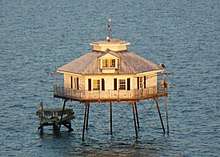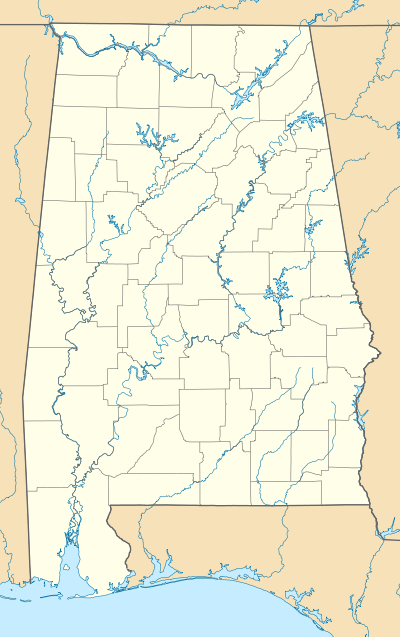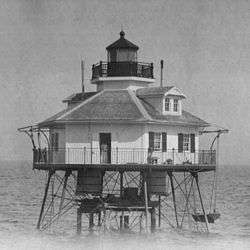Middle Bay Light
 Middle Bay Light in Mobile Bay, near Mobile, Alabama. | |
 Alabama | |
| Location | Middle of Mobile Bay, Mobile Bay, Alabama |
|---|---|
| Coordinates | 30°26′17.60″N 88°0′40.48″W / 30.4382222°N 88.0112444°WCoordinates: 30°26′17.60″N 88°0′40.48″W / 30.4382222°N 88.0112444°W |
| Year first constructed | 1885 |
| Automated | 1935 |
| Foundation | screw piles |
| Construction | wooden screw-pile lighthouse |
| Tower shape | hexagonal frustum structure with platform, keeper’s quarter and mast with beacon centered on the roof |
| Markings / pattern | white lighthouse |
| Height | 41 feet (12 m) |
| Focal height | 48 feet (15 m) |
| Original lens | Fourth order Fresnel lens, 1885 |
| Current lens | 155 mm solar-powered lens |
| Light source | solar power |
| Characteristic | Fl R 6s., bell struck by machinery every 5 seconds. |
| Admiralty number | J3488 |
| ARLHS number | USA-505 |
| USCG number | 4-6490 |
| Managing agent | Alabama Historical Commission[1] |
| Heritage |
place listed on the National Register of Historic Places |
|
Middle Bay Light | |
 Middle Bay Light circa 1940. | |
| Architect | Captain John Grant |
| NRHP reference # | 74000429[2] |
| Added to NRHP | December 30, 1974 |
Middle Bay Light, also known as Middle Bay Lighthouse and Mobile Bay Lighthouse, is an active hexagonal-shaped cottage style screw-pile lighthouse. The structure is located offshore from Mobile, Alabama, in the center of Mobile Bay.
History
The station was activated in 1885. In 1916 the keeper's wife gave birth to a baby that summer at the station. According to the Alabama Lighthouse Association web site, the keeper brought a dairy cow to the station and corralled it on a section of the lower deck because his wife was unable to nurse the newborn baby. All had to be evacuated when the station survived but was damaged by a hurricane that year. The light was automated in 1935.
The lighthouse was placed on the National Register of Historic Places on December 30, 1974.[2] In 1984 the lighthouse was stabilized by Middle Bay Light Centennial Commission in preparation for the centennial celebration. In 1996 the Coast Guard loaned the original Fresnel lens to the Ft. Morgan Museum for public display. In 2002 restoration efforts were begun to repair the lighthouse.
In 2003, a real-time weather station was added to the lighthouse by the Dauphin Island Sea Lab and the Mobile Bay National Estuary Program. Still running, the weather station, one of seven in Mobile Bay, samples precipitation, total and quantum solar radiation, air temperature, relative humidity, wind speed and direction, barometric pressure, water temperature, salinity, water depth, and dissolved oxygen. These data can be seen in real-time at www.mymobilebay.com. From late 2011 - mid 2014 currents and waves were also displayed.
Light

Whale oil was the first fuel used and the lighthouse tenders worked in shifts making sure that the lamps did not go out and smoke the lens. In later years kerosene was used and eventually they were converted to electricity.[3]
See also
References
- ↑ Mobile Bay (Middle Bay) The Lighthouse Directory. University of North Carolina at Chapel Hill. Retrieved 6 June 2016
- 1 2 National Park Service (2008-04-15). "National Register Information System". National Register of Historic Places. National Park Service.
- ↑ "The Fresnel Lens". BrownMarine.com. Retrieved 2007-04-23.
External links
- Alabama Lighthouse Association.
- Rowlett, Russ. "Lighthouses of the United States: Alabama". The Lighthouse Directory. University of North Carolina at Chapel Hill.
- Lighthouse Friends, Middle Bay Light.
- Middle Bay Lighthouse (Mobile) - United States Lighthouses
| Wikimedia Commons has media related to Middle Bay Lighthouse. |